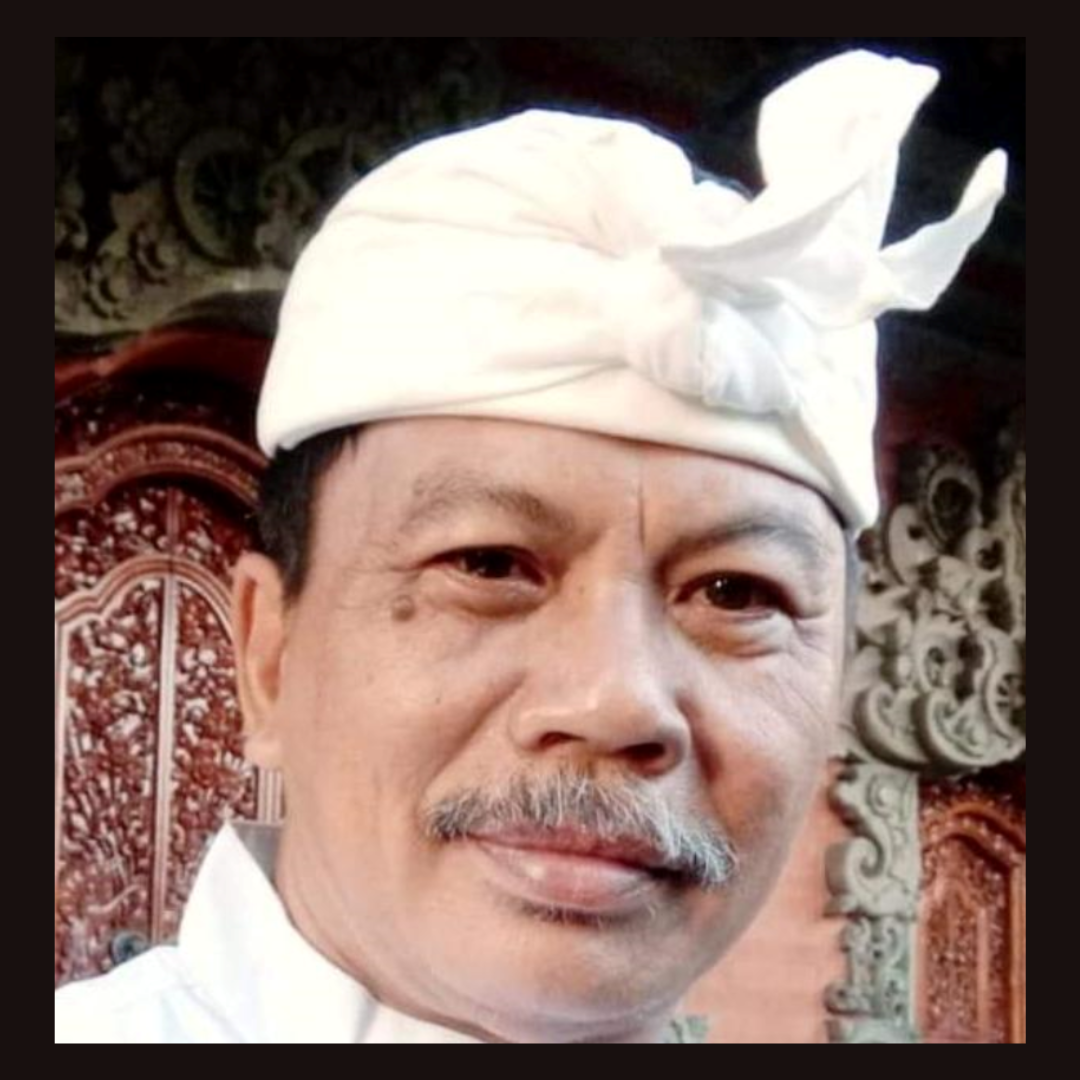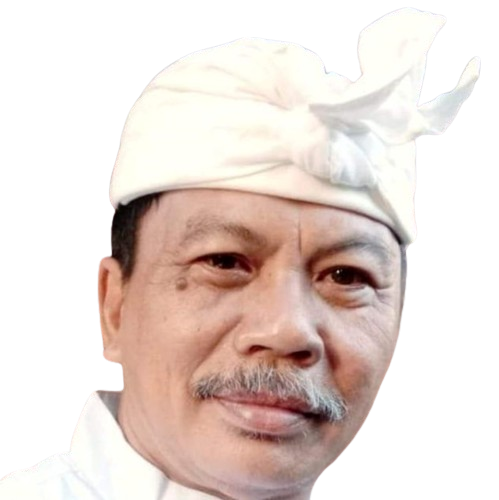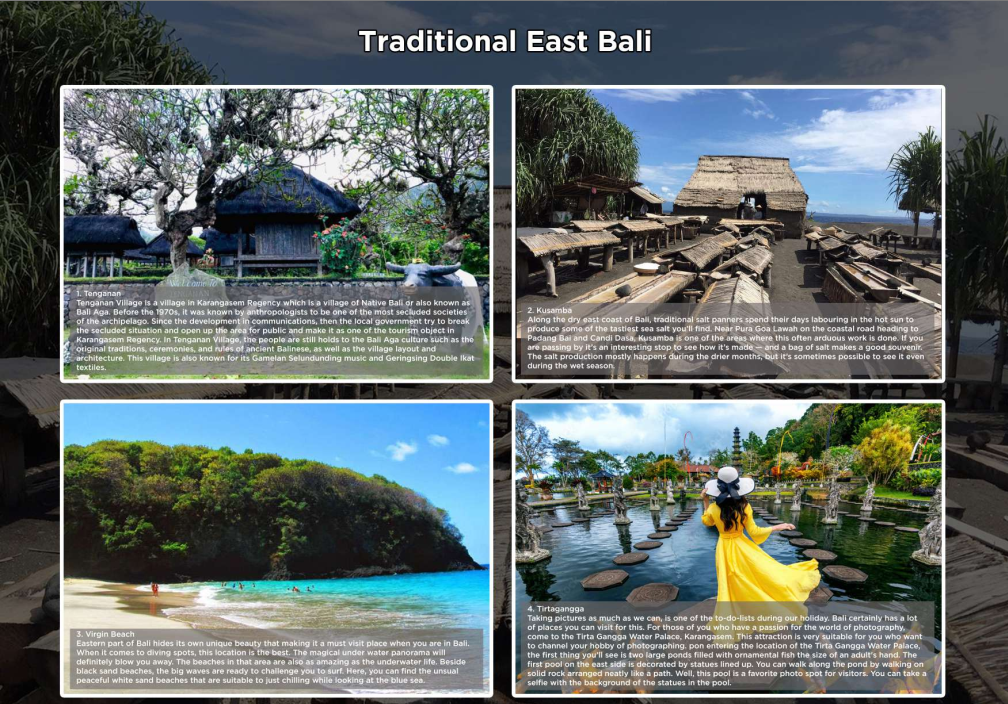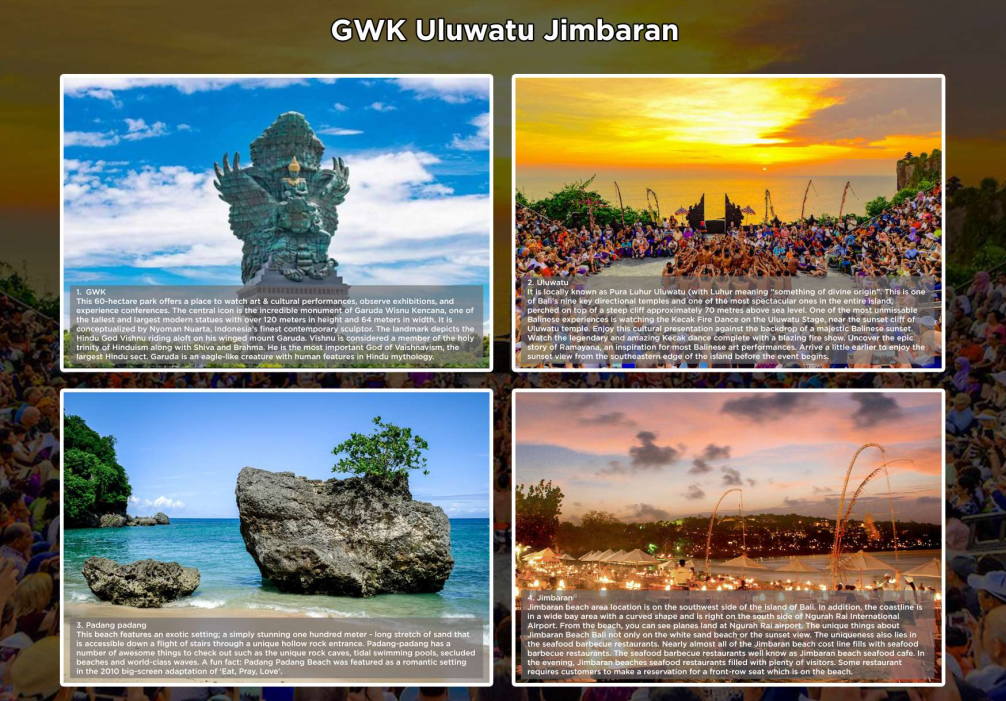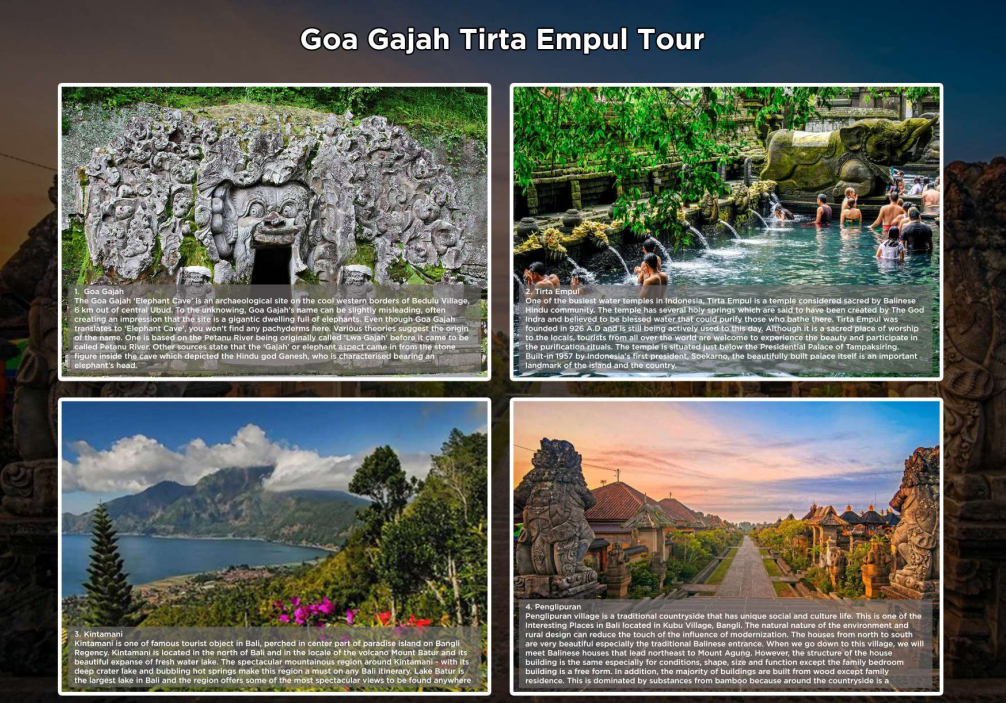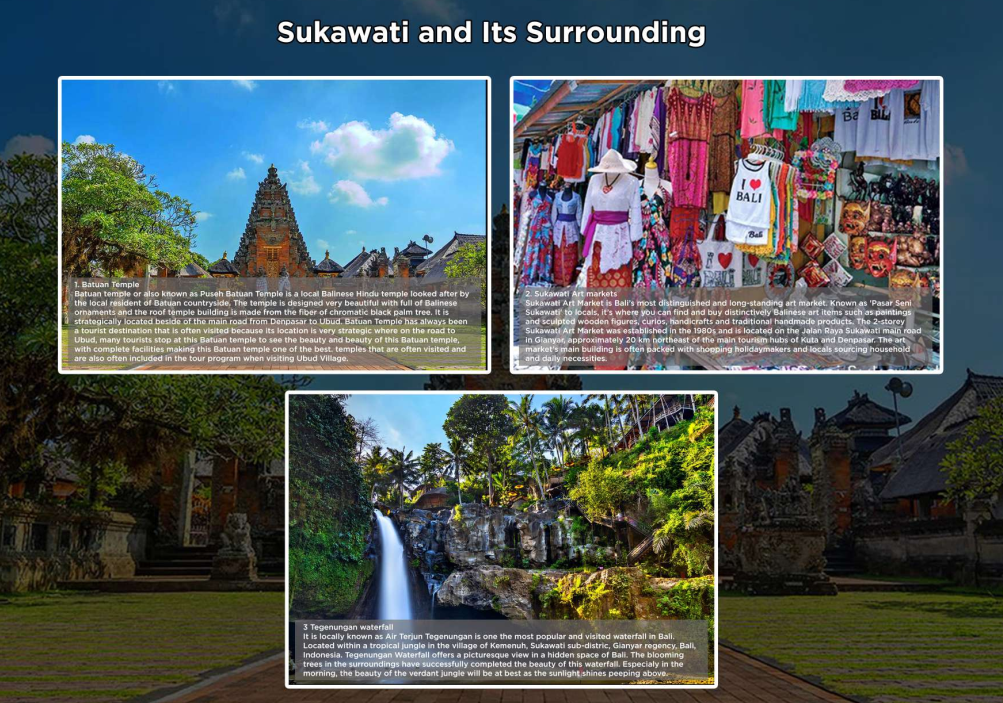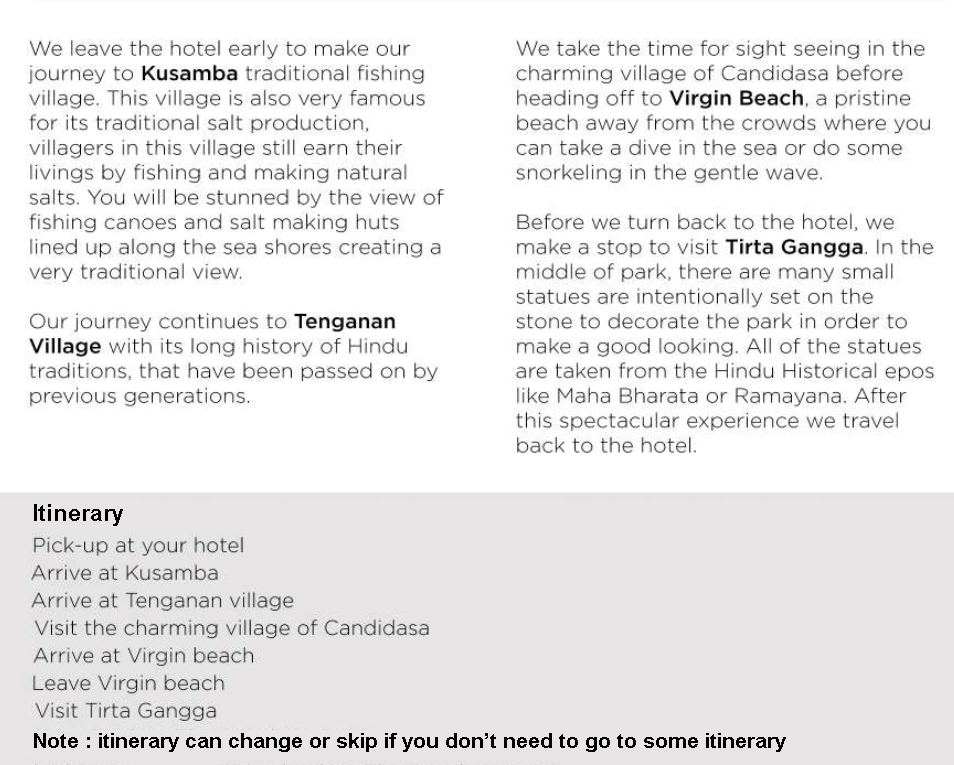
Kusamba
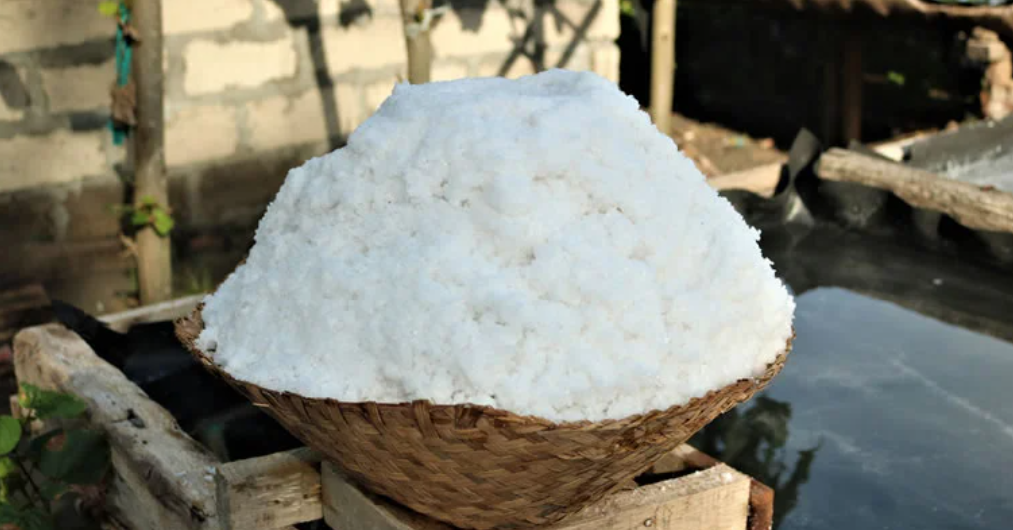
Bali salt, the process of making salt at Kusamba Village is not as easy as we think to imagine, just dry the seawater and become salt. Farmers must work hard from morning to evening. The results they get also not much. In hot sun conditions, per day only get 8 -10 kg of salt. The salt content of the water Kusamba sea is not too high which makes the process of making salt is not easy and simple. This job requires not only high patience but also work hard and takes a lot of energy. Below are some steps for the farmers to process traditionally make salt.
Preparation of the Sand Field
Usually, Bali salt farmers at Kusamba Village will prepare the sand field one day before or early morning before they start watering. The sand, in the beginning, was taken from the beach and after that, they always reuse the sand after they are filtered by seawater.

Watering of the Sand Field
The salt farmers will start work early morning as they can around 6 am before the sun gets hotter. They will water the sand field that has been leveled. They don’t use a hose or a machine for watering but Bali salt mining Farming in Kusamba Village uses simple tools that they made from wood and old tires and made like a bucket to take seawater. While walking and carrying this seawater then the farmer shakes his homemade bucket back and forth until it splashed into the sand field. The average distance from the beach to the sand field they made is 15-20 meters. Need around 25-35 times take water to be able to flush all the sand. The sand that has been watered will wait until it’s dried and produces flat sand. Usually arrive mid-afternoon in the scorching sun.

Collecting of Dry Sand
While waiting for the sand to dry, the farmer will empty the wooden sandbox by draining the wet sand inside the box used yesterday. This wet sand is clean so it must be placed in a good place to flatten and reuse the next day. The sand flakes obtained are then taken and placed into the empty wooden sandbox.

Filtering of Dry Sand by Seawater
Dry sand which is placed in the wooden sandbox can be used as a seawater filter. In this case, farmers still have to take seawater back until the wooden sandbox is filled with seawater. The wooden sandbox will be given a hole that is given a small pipe below to drain the filtered seawater. The filter results will be Salt Farmers Collect the dry sand that is been doused with Seawater Using Enumeration Dry Flat Sand that has been collected. The results of the first filter cannot be used as salt. However, it must be filtered back to 3 stages with use sandblasting, become the water very salty.

Drying Seawater in Hot Sunlight Become Crystals
The sea water that has undergone 3 times of this filtering will later dried to take the crystals in the form of salt. The sea water poured into a block of coconut wood that has been made a shallow manger. The process of crystallizing seawater into salt is the fastest taken for one hour days when the sun is really hot. When the sun is not too much hot, then this process can take 2-3 days. After the sea water crystallizes into salt, the Bali salt mining farmers are ready to reap the fruits of his labor.

Collecting the Salt
The harvesting process is also still using tools simple. Farmers use coconut shells that are split and use them to scoop out the salt crystals. For Draining salt from the brine, the farmer lays down the salt of his harvest in a place made of woven bamboo. After Salt Crystal no more drops of water, then the salt is ready to be marketed.

Tenganan Village
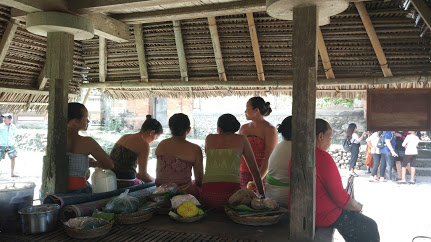
Tenganan is an ancient village, home to Bali natives Bali Aga people. The village is beautiful and photogenic. The villagers still work on their craft as they have done for generations. Items cost a little bit more pricey here but having the opportunity to watch how much skill and patience go into a piece is priceless. The popular products from Tenganan is double-woven textile called ikat. Other souvenirs like traditional calendar, maps and carvings also can be found here. The village was clean and tidy, the people were friendly and not at all pushy.
During an annual event Mekare-kare all men in this village will join on a war-festival by fighting each other on a stage using only rattan shield and prickly pandan leaves as the weapon. The ladies will watch the fight and occasionally chanting few traditional songs by the stage.
Tenganan village, the beauty of the oldest village in Bali, that existed in Bali before the entry of Hindu influence from Majapahit kingdom.
And holding rules and norms passed down from generation to generation in the midst of changing times.
The island of Bali has many ancient villages that hold traditions from generation to generation to this day.
The existing tradition from time to time and has become the standard rule governing the life order of the village community.
And one of the villages in Bali is Tenganan Village or known as Tenganan Pengrisingan.
Balinese people generally refer to these villages as Bali Aga villages. Tenganan Village.
Where the pattern and order of life for the Balinese village community is quite different from the pattern and order of life for Balinese people in general.
Located in the Manggis sub-district, Karangasem district and is close to the Candi Dasa tourist area.
Which is only about 5 km away and takes about 10 minutes to drive, so when you are in the Manggis sub-district you can visit two tourist attractions at once.
As one of the cultural tourism destinations in Bali, the uniqueness of Tenganan village has its own charm for tourists who visit Tenganan village.
Especially in the system that applies to the life of village communities that regulate all forms of life in society.
There is an endogamy system. In which indigenous people must comply with customary law.
And requires them to marry other indigenous people of Tenganan village.
And if you violate these provisions, you will get a customary sanction, namely leaving the customary village.
This is done to maintain the continuity of the Tenganan natives.
There are many unique things that you can find while traveling in the village.
The History Of The Traditional Village

Tenganan comes from the middle word or ngetengahang which means movement or movement to an area or place that is in the middle or deeper.
And in this case it refers to the movement of village people from the coastal area to residential areas in the middle of the hill, namely Kauh Hill (west) and Kangin Hill (East).
The history of this village, according to the version of the belief of the indigenous people, is inseparable from the mythology of the giant king Mayadenawa in Bedahulu.
Who is said to be an arrogant king who was eventually defeat by the god Indra in battle.
After the victory, the god Indra perform the Aswameda Yadnya ceremony by sacrificing a supposedly powerful horse named Ucchaih Srawa.
The Ucchaich Srawa’s horse, know that he would be sacrifice in the Aswameda Yadnya ceremony and finally escape
And to find the horse ucchaich Srawa god indra sent the village community to look for it.
And in his search the horse was dead.
Then Dewa Indra also gave the area to the people who found the horse carcass. On condition that the area is determine as far as the smell of the horse carcass can be smell.
And to get a wider area, the horse carcasses were cut up and spread in all directions as far as the people could walk.
The role of god Indra was so great in fighting the arrogant King Maya Denawa.
Causing the people of Tenganan to become adherents of belief in the god Indra.
And you can find this in the mekere-mekere tradition, namely the pandan war tradition carried out by the people of Tenganan village from generation to generation.
The Attraction of Tenganan Village

As a cultural tourism destination, of course Tenganan Village has culture and art that make it interesting.
And this is the culture and art by the people of Tenganan Village.
1. The Art of Weaving double tie Gringsing Cloth
Gringsing woven fabric comes from the words gring and sing, where “gring” means sick and “sing” means not.
Which means anyone who uses this gringsing cloth is expected to avoid danger and disease.
Using a double tie woven technique while the manufacture of gringsing woven cloth takes months or even years.
Based on the myth, the existence of ngringsing cloth originates from God Indra’s admiration for the beauty of the sky at night, and describes this beauty through woven motifs.
The gringsing cloth motif uses tridatu colors, namely red, black and yellow.
Which these colors are produced from natural ingredients.
Such as a mixture of white kedungung tree petals (baccaurea racemosa) and the roots of the noni tree (Morinda Citrifolia) for the red dye.
Then candlenut fruit oil as the yellow dye and the taum tree as the black dye.
And Gringsing cloth weaving has many motifs.
Such as Lubeng, Sanan Empeg, Cecempakaan, Cemplong, Cemplong, Gringsing Isi, Wayang.
And teteledan, enjekan siap, pepare, gegonggangan, sitan pegat, Dinding Ai , Dinding Sigading, Talidandan, Batu tuung.
2. Pandan War Tradition (Mekere -Kere)
This tradition involves the traditional Tenganan village youths. This procession is an offering ceremony to honor the ancestors and the god Indra.
This tradition begins with a ritual around the village to ask for protection and safety.
The pandan war tradition uses tied thorny Pandanus which is likened to a mace. And a shield or shield made of rattan.
The youths will take turns doing the pandan war for 1 minute, and after finishing the pandan war, the youths will be treated with traditional medicine in the form of a mixture of grated turmeric and coconut oil.
And at the end of the tradition, the participants and the community carry out the Megibung tradition, namely eating together by eating the food that is available.
3. Prasi Painting (Lontar Writing Art)
Is one of the traditional fine arts that from generation to generation because of its characteristics which have aesthetic value.
The main ingredient of this art is palm leaves which are paint proccess using a special knife call Pangrupak.
when traveling to Tenganan village you will find Prasi writing craftsmen.
4. The Architecture Of Tenganan Village Buildings is Linear from North to South
The traditional settlement of Tenganan village has a pattern that is arrange linearly from north to south with the front gate entering the house yard called Jelanan Awangan facing west or east.
The awangan is a layer of river stone with steps as a feature of the megalithic culture, which is getting higher and higher to the north.
Is the outermost courtyard of the indigenous people’s settlement which functions as a social space and a road.
The boundary between One Awangan and the Other is a water ditch call Boatan.
And the backyard boundary of each house is in the form of a water ditch as deep as 1 – 1.5 meters which is call Teba Pisan.
Tenganan village traditional house made of a mixture of red stone, river stone and soil.
And rumbi leaves as the roof of each resident’s house. Marked by a wide entrance and the same size as adults.
The settlement of the Tenganan village community is centered in the middle of the village which has an area of 1500 hectares.
Which is surrounding by hills on the east, west and north while the southern part is the exit from the village.
Village community activities in the center of the village. While the west and east sides are use for graves, and on the north side for economic resources and on the south side are use for ancestor worship.
The customary settlement consists of three banjars, namely Banjar Kauh (West), Banjar Tengah and Banjar Kangin (East).
Banjar Kauh and Banjar Tengah are settlements for the indigenous people of Tenganan.
While Kangin banjar is a banjar inhabit by residents who have violate customary rules as well as outsiders who are asking to stay by the traditional village for certain purposes.
And for residents who are marry, especially residents of Banjar Kauh and Banjar Tengah.
They are live separately from their parents and build buildings from vacant land in traditional villages and follow the structure of the Tenganan house.
Tips to Visit Tenganan Traditional Village Bali

There are no specific tips for visiting Tenganan Village, it’s just that you are obey to respect and maintain the environment and nature of Tenganan Village and the customs of the Tenganan people.
You can visit this village anytime but the best time to visit this village is between June and July, so you can witness the famous Mekare – kare tradition from Tenganan village.
Virgin Beach
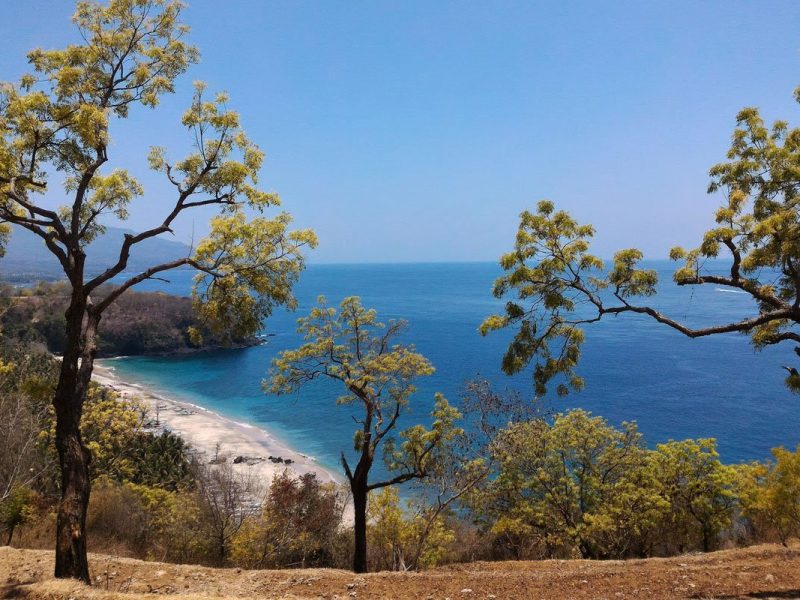
Virgin Beach Karangasem is nestled along the unspoiled coastline of East Bali. It is also known as Pantai Pasir Putih and is a concealed treasure waiting to be unveiled. This hidden paradise invites explorers with its fine white sands, crystal-clear turquoise waters, and serene atmosphere, providing an enchanting refuge from the hustle and bustle of contemporary life. Here, you can enjoy a tranquil retreat, thrilling water activities, or a moment of pure relaxation. Virgin Beach Karangasem assures an indelible beachfront experience amidst the pristine natural beauty of East Bali.
Escape to the allure of Virgin Beach Karangasem, where the powdery white sands stretch along the shoreline. It creates an intimate haven for those seeking solace and rejuvenation. The inviting turquoise waters allow water enthusiasts to partake in exciting activities. Meanwhile, the overall tranquillity of the surroundings offers a haven for those searching for a serene getaway. This place stands as a testament to the untouched charm of East Bali. It promises an unforgettable beach experience that transcends the ordinary and transports visitors to unparalleled natural beauty.
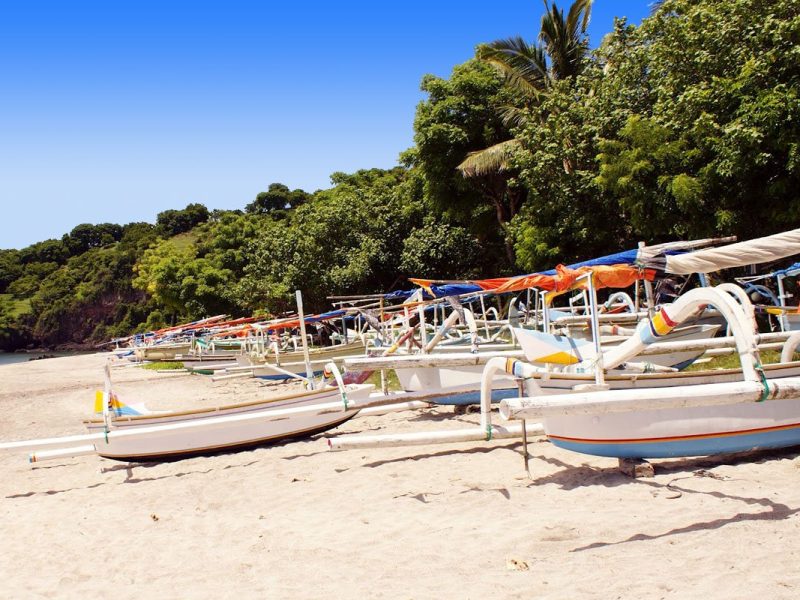
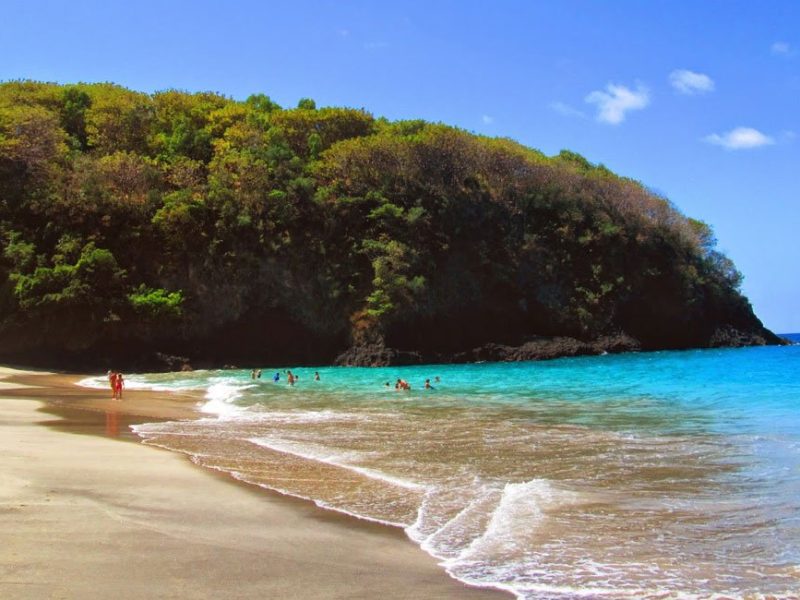
ABOUT VIRGIN BEACH KARANGASEM
General Information
Virgin Beach Karangasem is located in the Karangasem regency of East Bali, approximately 6 kilometres east of Candidasa Beach. Accessible via a scenic drive through lush landscapes and rural villages, the beach offers a secluded setting perfect for unwinding and soaking up the sun. Despite its growing popularity among tourists, Virgin Beach Karangasem retains its pristine charm and unspoiled beauty, making it a favourite destination for travellers seeking tranquillity and natural splendour.
History
Virgin Beach Karangasem has a rich history dating back centuries and is known for its traditional fishing communities and cultural heritage. In the past, the beach was frequented by local fishermen who relied on its abundant marine resources for their livelihoods. Over time, word of the beach’s beauty spread, attracting visitors from near and far to its shores. Today, Virgin Beach Karangasem is a testament to Bali’s natural wonders, offering a glimpse into the island’s timeless allure and coastal charm.
The Highlights:
- Powdery White Sands: Sink your toes into the soft, powdery sands of Virgin Beach Karangasem, ideal for sunbathing, beachcombing, and strolls along the shore.
- Turquoise Waters: Take a refreshing dip in the crystal-clear waters of the Indian Ocean, perfect for swimming, snorkelling, and exploring the vibrant underwater world.
- Serenity and Seclusion: Escape the crowds and enjoy the tranquillity of Virgin Beach Karangasem, surrounded by lush greenery and panoramic ocean views that create a sense of peace and relaxation.
- Water Activities: Embark on exciting water adventures, including surfing, boogie boarding, and kayaking, or bask in the warm tropical sun and let the gentle sea breeze soothe your soul.
Tirta Gangga
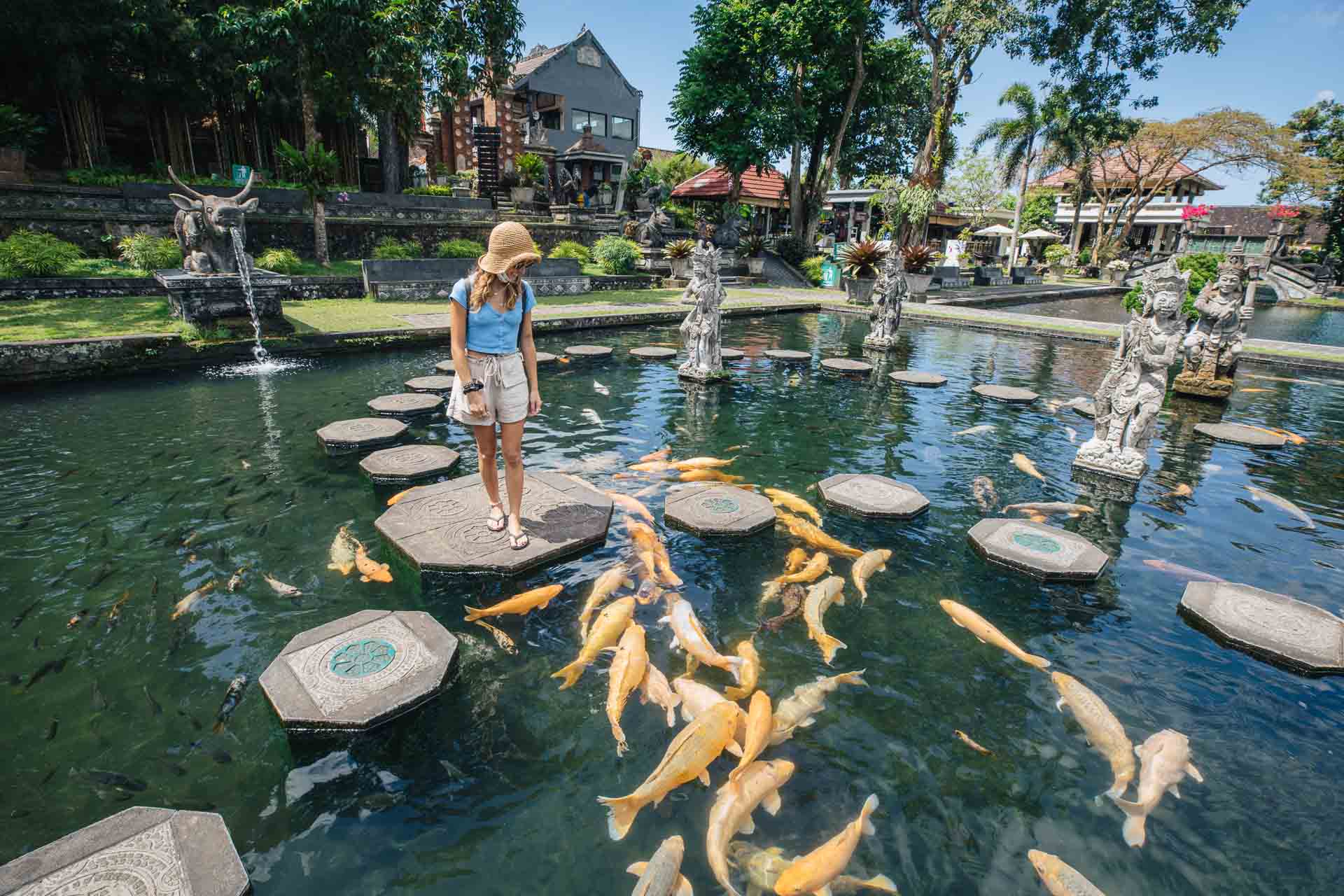
Tirta Gangga is a stunning water palace in Bali, Indonesia, that will take your breath away with its beauty and charm. Built by a king in the 1940s, this royal complex features pools, fountains, gardens, and sculptures that reflect the rich culture and religion of Bali.
Whether you want to swim in the crystal-clear water, feed the colorful fish, explore the lush greenery, or take amazing photos, Tirta Gangga is a must-visit attraction for anyone who loves nature and history. In this guide, we will tell you everything you need to know about Tirta Gangga, including how to reach, when to go, and what to do there. Read on and get ready to be enchanted by this magical water palace.
Things to Do at Tirta Gangga Water Palace
There are plenty of things to do at Tirta Gangga Water Palace that will make your visit memorable and enjoyable. Here are some of the highlights:
Swimming in the pools and fountains:
One of the main attractions of Tirta Gangga is the opportunity to swim in the refreshing water of the pools and fountains. The water is sourced from a natural spring and is believed to have healing properties. You can choose from three pools, each with different depths and sizes. The largest pool, called Abang, is the most popular and has a stunning view of the rice terraces and the mountains. The second pool, called Kediri, is smaller and quieter, and has a fountain with a dragon statue. The third pool, called Karangasem, is the shallowest and has a fountain with a lotus flower. The entrance fee for swimming is 20,000 IDR (about 1.4 USD) per person, and you can rent a locker and a towel for an extra fee.
Feeding the fish and admiring the aquatic life:
Another fun activity at Tirta Gangga is feeding the fish and admiring the aquatic life. The water palace is home to hundreds of fish, mostly koi and goldfish, that swim around the pools and fountains. You can buy fish food for 5,000 IDR (about 0.4 USD) per bag and watch the fish swarm to your hand. You can also see other aquatic creatures, such as turtles, frogs, and eels, in the water. Feeding the fish is not only entertaining, but also considered a good deed, as the fish are sacred to the Balinese people.
Exploring the gardens and the sculptures:
Tirta Gangga is not only a water palace, but also a beautiful garden that showcases the natural beauty of Bali. You can explore the garden and admire the variety of plants, flowers, and trees that grow there. You can also see the sculptures and statues that decorate the garden, such as the mythical creatures, the Hindu gods, and the royal family. The sculptures and statues are made of stone, wood, or metal, and have intricate details and designs. The garden is well-maintained and clean, and you can walk along the pathways and bridges that connect the different areas of the water palace.
Taking photos and selfies with the scenic views:
Tirta Gangga is a paradise for photographers and selfie lovers, as it offers many scenic views and photo opportunities. You can capture the stunning scenery of the water palace, such as the pools, fountains, gardens, and sculptures, as well as the surrounding landscape, such as the rice terraces, the mountains, and the sky. You can also pose with the fish, the statues, or the water features, and create some amazing shots. Tirta Gangga is especially beautiful in the morning and the evening, when the light is soft and the colors are vibrant. You can also use some props, such as umbrellas, hats, or flowers, to add some flair to your photos.
Learning about the culture and the religion of Bali:
Tirta Gangga is not only a tourist attraction, but also a cultural and religious site that reflects the history and the beliefs of Bali. You can learn about the origin, the construction, and the restoration of the water palace, as well as its significance to the Balinese people. You can also learn about the Hindu rituals and ceremonies that take place at the water palace, such as the purification, the offerings, and the prayers. You can also witness the local people performing their daily activities, such as farming, fishing, or cooking, and get a glimpse of their lifestyle and culture.
